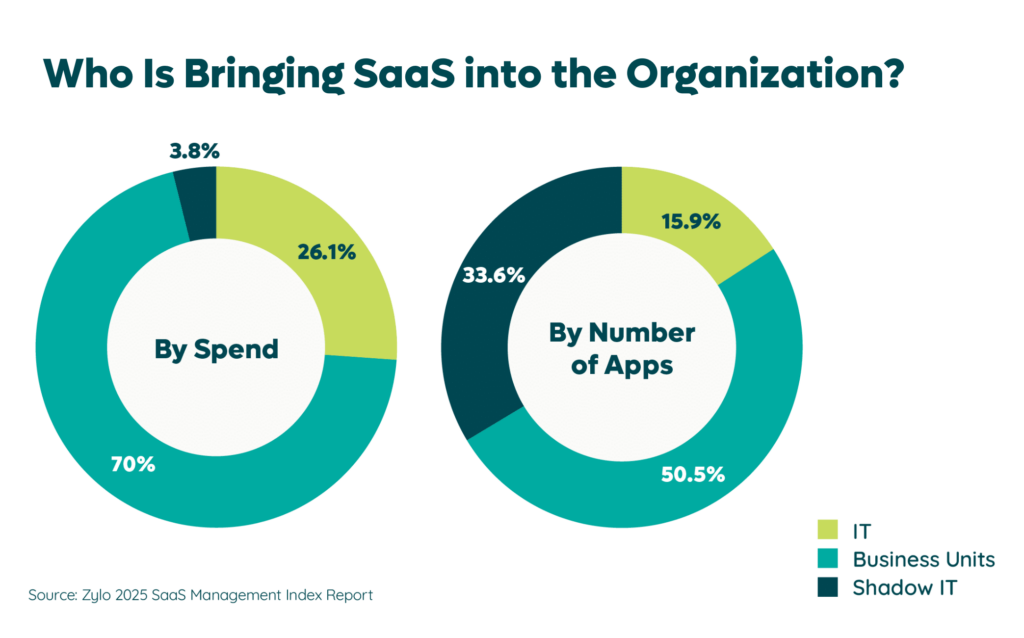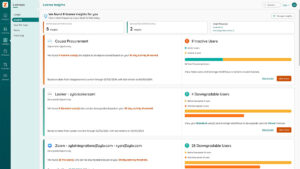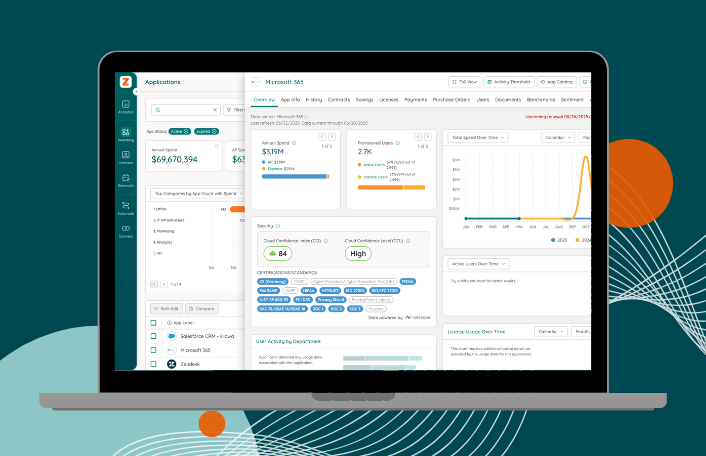
FinOps SaaS Myths Busted: SaaS vs Cloud (and Why It Matters for…
Table of Contents ToggleHow FinOps Teams Commonly Understand SaaS—and What’s MissingSaaS...
Back
Back
Search for Keywords...
Blog

Table of Contents
Software is more accessible than ever before, thanks in part to the rise of software-as-a-service (SaaS) over the past two decades. This has been great in terms of utility. Teams can now get what they need when they need it. However, the democratization of software acquisition has become a nightmare for procurement. It’s no longer possible to know everything that’s entering the environment or who owns it. Therein lies the problem.
The average organization sees six new applications enter their tech environment. And most organizations don’t even know it’s happening. This lack of visibility in the SaaS stack means it’s impossible for procurement to understand what applications have been purchased, what they’re spending, or even stay ahead of renewals. It’s the wild west of software management, and it’s easy to feel like the lone sheriff.
Instead of massive servers and months-long implementations, any employee with a credit card can purchase SaaS and begin using the tools in minutes. It’s why the average company now employs 275 SaaS applications.

It’s a staggering number. But it all comes down to SaaS governance through an effective procurement management system.
In SaaS, procurement management involves the sourcing and purchasing of software applications, as well as overseeing contract governance and vendor relations. Organizations employ procurement strategies and hire procurement management teams to vet potential software purchases, examine risks, control costs, and proactively manage license renewals.
Before the explosion of cloud-based applications, procurement teams took the lead in vetting and evaluating different vendors, communicating options to senior leadership, and managing the implementation. Often, this involved physically installing the software on servers and individual computers.
What used to be a straightforward undertaking with clearly defined processes is far more convoluted — especially if you consider lines of business (LOBs) and individual employees now control 74% of SaaS spend, a 2.8% increase over the previous year.

These off-the-grid purchases not only hinder SaaS Management, but also weaken purchasing power for procurement professionals. To stay abreast of their ever-growing SaaS inventories, consider using technology to optimize and enhance SaaS procurement management. Otherwise, procurement will be stuck with a time-consuming spreadsheet that will be constantly outdated as applications enter and leave the environment.
“Without digitalization,” Said ProcureTech Founder and CEO, Lance Younger. “Procurement can’t realize their potential.”
And that’s true. Every organization’s SaaS ecosystem is different and constantly changing over time. Bringing the right tech like a SaaS procurement management system gives procurement the elasticity and adaptability to tackle an ever-changing SaaS portfolio.
SaaS procurement management isn’t rocket science. It simply requires company-wide alignment and a robust management tool. Look for these five core benefits of best-in-class procurement management systems:
Instead of relying on manual processes prone to user error, SaaS management solutions use artificial intelligence (AI). It’s a key tool during SaaS discovery that helps to spotlight and document all SaaS tools across an organization, including applications purchased outside of the traditional procurement process.
It’s important to note here that discovery is not a one-and-done project. It’s a continuous process as new solutions are purchased. With a SaaS management solution like Zylo, you’ll be automatically alerted when new purchases are made – even purchases outside your procurement policy.
Additionally, many procurement management solutions integrate with accounting and finance software, including Expensify and NetSuite, to log purchases in real-time. Your IT or software procurement teams can use this data to determine which new apps require further scrutiny for security and compliance.
How the Zylo Discovery Engine Powers the Most Comprehensive SaaS Management Platform
Learn MoreOne of the biggest problems of the SaaS environments today is there’s no process in place to purchase or request new applications. And that’s how shadow IT creeps into the environment in the first place – which poses its own problem. Applications you can’t see are applications where you can’t manage the contracts, renewals, or even contact the vendor.
This snowballs over time as a source of unknown risk and spend. In terms of risk, there are compliance and data breaches to worry about. On the subject of spend, shadow IT can easily become a source of inefficient purchasing, uncontrolled spend, redundancy, and much more. As such, SaaS governance quickly becomes unmanageable without a dedicated procurement management system.

Consider how 1 in 15 (6.6%) employees purchase SaaS applications for business use via expense reimbursement. Not to mention most organizations average one SaaS renewal every business day (247 annually). It’s easy to see how the situation can quickly become untenable. That’s why a procurement management system is so important – it helps organize your contracts and renewals in an easy-to-manage central location.
The technology catalogs SaaS contracts and renewal terms in a central hub and alerts you to upcoming renewal deadlines. It eliminates auto-renewals for tools you no longer use or need, and prevents the associated costs that come with missed renewals. You can use these insights to measure your total application spend and estimate future costs.
Large organizations, on average, are paying for more than 660 SaaS applications. How can you be certain you’re getting the right price for every single one? Answering that question would require an exorbitant amount of hours of research.
Alternatively, you could use a tool like Zylo Benchmarks to get this data on demand for popular applications.
For example, imagine you want to know what your peers are paying for the same email marketing application. You could ask around in the communities you’re part of or rely on intuition. Or you could use benchmarking to really know the exact data so you can highlight it the next time you negotiate a renewal or new contract.

SaaS Management solutions provide real-time visibility into application usage (or lack thereof) for each license and the overall number of licenses for specific applications. That way, procurement teams can make data-driven decisions to reduce costs and boost profitability.
These insights guide investment into new software your employees need and reveal unused features and licenses, which you can use to deprovision or downgrade SaaS licenses, also known as rightsizing.

At the end of the day, unmanaged SaaS procurement easily grows unruly, especially when you consider the large number of applications that enter and exit your organization each month. Instead of relying on manual spreadsheets or allowing individual business units to self-report SaaS adoption, consider investing in a SaaS procurement management system, like Zylo.
Using Zylo for Procurement lets you:
Schedule a demo today to see the full potential of a procurement management system powered by Zylo.

Table of Contents ToggleHow FinOps Teams Commonly Understand SaaS—and What’s MissingSaaS...

Table of Contents ToggleWhat Is an E-Commerce Tech Stack?Why Your E-commerce...

Table of Contents ToggleWhat Is Procurement Management?Key Benefits of A Strong...

Table of Contents ToggleWhat Is Procurement Management?Key Benefits of A Strong...
| Cookie | Duration | Description |
|---|---|---|
| cookielawinfo-checkbox-analytics | 11 months | This cookie is set by GDPR Cookie Consent plugin. The cookie is used to store the user consent for the cookies in the category "Analytics". |
| cookielawinfo-checkbox-functional | 11 months | The cookie is set by GDPR cookie consent to record the user consent for the cookies in the category "Functional". |
| cookielawinfo-checkbox-necessary | 11 months | This cookie is set by GDPR Cookie Consent plugin. The cookies is used to store the user consent for the cookies in the category "Necessary". |
| cookielawinfo-checkbox-others | 11 months | This cookie is set by GDPR Cookie Consent plugin. The cookie is used to store the user consent for the cookies in the category "Other. |
| cookielawinfo-checkbox-performance | 11 months | This cookie is set by GDPR Cookie Consent plugin. The cookie is used to store the user consent for the cookies in the category "Performance". |
| viewed_cookie_policy | 11 months | The cookie is set by the GDPR Cookie Consent plugin and is used to store whether or not user has consented to the use of cookies. It does not store any personal data. |
